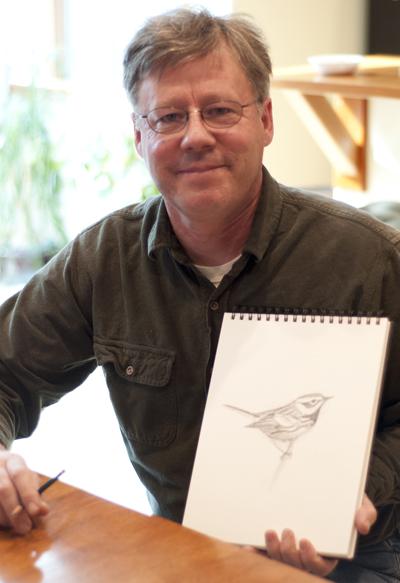This article originally appeared on BirdNote.
Famed illustrator, ornithologist, and author David Allen Sibley dropped by the BirdNote studio while in Seattle on a book tour. We talked to him about his art, the artistic process behind his best-selling The Sibley Guide to Birds, and how his appreciation of nature was cultivated as a child. He stayed a few extra minutes to sketch a bird for an appreciative BirdNote team. Thankfully, our cameras were rolling. David finds it easiest to sketch a bird he’s seen recently. On this day, that fortunate bird was a Townsend’s warbler spotted on a field trip David had taken that morning with the local Audubon chapter.
In preparation for his numerous publications, David has sketched literally thousands of birds. It was fascinating to watch as this bird gradually took shape, all from memory. We hope you enjoy this insight into his artistic process.
View the original video on YouTube. Here’s a transcript:
Drawing is a way—it’s a method of looking at birds, for me. And the sketching, it’s not so much the drawing that I produce but the process of getting there, the observation that is required. And that leads to all kinds of discoveries.
I know the shapes and the postures and the general color patterns. I know what I’m shooting for, based on all my own experience and my sketches. I use photographs as reference material to make sure I’m getting the details right. But I’ve found that what I’m sketching, what I’m drawing and then painting, the shapes and proportions and postures that I’m painting, they are never exactly what I see in a photograph. It’s always a merging of all kinds of different experiences that I had. But you won’t ever find that particular shape in a photograph because what I’m trying to paint is not one instant in time. It’s sort of the impression of many experiences.

Courtesy of Adam Sedgley
So I spent years in the field, just traveling and birding and sketching. Just doing pencil sketches, getting to know the birds, learning the shapes and the postures and the general patterns. And then when I go into the studio to paint, I have my sketches. I gather together all the photographs I can find. I’ve already visited museums and looked at specimens and taken notes on those. So I have all that material and I’m working on paintings. But what I try to put into the painting is sort of a “summary” or a compilation, a synthesis of all of the things that I’ve seen, all the things that I’ve learned, and to show a generic … not generic… but a stereotypical bird of that species of that plumage.
Most people—I know it’s true for me—I enjoy looking at an artist’s sketches. If I’m at an art museum, the sketches that an artist does are often much more interesting than the finished painting. And I think part of that is that there’s so much left out of the sketch. It’s just an outline, a suggestion of what might be happening there. And we really have to interact with the sketch. We have to fill in a lot of the details in our mind, fill in the gaps and create a whole scene that, in our mind, fills in what the artist has started to suggest there.
And when I’m painting in the field guide, I’m trying to simplify as much as possible. So my paintings in the field guide, I’ve tried to just show the birds, the way they would look, at a distance, through binoculars, the broad outlines of patterns and colors, the shapes, but a sort of “generic” neutral posture for every species, neutral lighting, no background, no habitat. So there’s nothing there that suggests a particular experience that you’ve had. It’s just the bird and its distinguishing features. Sort of a “patternistic impression” of what that bird will look like.
You can look at the illustrations in the field guide and there’s a lot there, and a lot of details that aren’t there. A lot that you can fill in. A lot of blanks. You can superimpose your own experience onto it.
BirdNote thanks David for taking the time with us that day!
“David Allen Sibley Sketches a Townsend’s Warbler” © BirdNote 2014
Video shot and edited by Adam Sedgley. Interview by Chris Peterson, recorded by John Kessler. Ambient audio edited by John Kessler.
